Illumina Bundle
Who Really Owns Illumina?
Understanding the ownership structure of the Illumina SWOT Analysis company is crucial for anyone tracking the biotechnology sector. From its inception to its current market position, the evolution of Illumina's ownership has significantly shaped its strategic decisions and market performance. Knowing who owns Illumina is key to understanding its future trajectory.
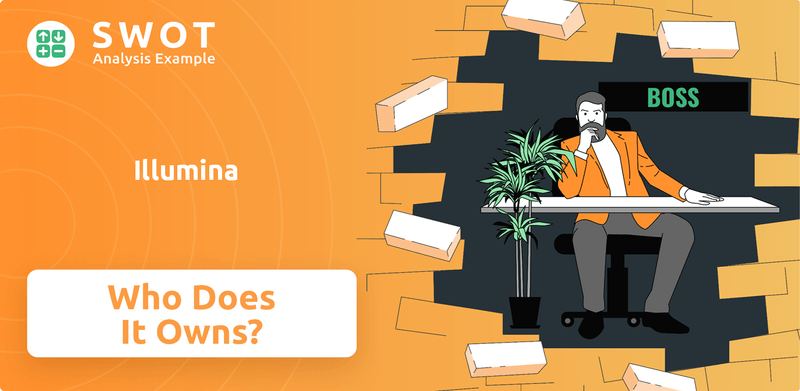
This deep dive into Illumina's ownership will explore the significant shifts in major shareholders, including its early investors and current ownership. We'll examine the influence of the Illumina board of directors and how these factors impact the company's overall strategy and value, including the Illumina stock performance. Furthermore, we will look into the Illumina company profile, including its market capitalization and recent developments in the Illumina acquisition history.
Who Founded Illumina?
The story of the Illumina company began in April 1998, with a team of five founders. These individuals brought together expertise in various fields to launch a company focused on revolutionizing genomic analysis. Their combined vision laid the groundwork for what Illumina would become.
The founding team included David Walt, Larry Bock, John Stuelpnagel, Anthony Czarnik, and Mark Chee. Each member played a crucial role in the company's early development, from securing the foundational technology to raising initial capital. Their collaborative efforts were essential in the company's early success.
Key to the company's inception was the licensing of the BeadArray technology from Tufts University, facilitated by Larry Bock and John Stuelpnagel. This technology became the foundation for Illumina's initial offerings. The team then brought in Anthony Czarnik and Mark Chee, adding expertise in chemistry and genetics to the mix, rounding out the founding team.
The initial seed funding for the company was approximately $1.5 million. This funding was crucial for supporting early research and development activities.
Illumina completed its initial public offering (IPO) in July 2000. The IPO raised roughly $100 million, which helped fuel the company's growth.
In 2001, the company started offering single nucleotide polymorphism (SNP) genotyping services. This marked an early step in providing accessible genetic analysis.
The first system, the Illumina BeadLab, was launched in 2002. This system helped to further the company's offerings in the field of genomics.
A notable legal event occurred in 2005 when co-founder Anthony Czarnik sued the company. The lawsuit highlighted early ownership dynamics.
The founding team's goal was to make genomics accessible through innovative technologies. This vision guided the company's early focus.
Understanding the early ownership structure and the founders' roles provides valuable insight into the Illumina company. The initial funding and the IPO were critical steps in the company's growth. The lawsuit in 2005 offers a glimpse into the early challenges and ownership dynamics within the company. The company's focus on making genetic analysis accessible was a core principle from its inception.
- The company was founded by David Walt, Larry Bock, John Stuelpnagel, Anthony Czarnik, and Mark Chee.
- Initial seed funding was approximately $1.5 million.
- The IPO in July 2000 raised around $100 million.
- The company launched its first system, the Illumina BeadLab, in 2002.
- A lawsuit involving co-founder Anthony Czarnik occurred in 2005.
Illumina SWOT Analysis
- Complete SWOT Breakdown
- Fully Customizable
- Editable in Excel & Word
- Professional Formatting
- Investor-Ready Format
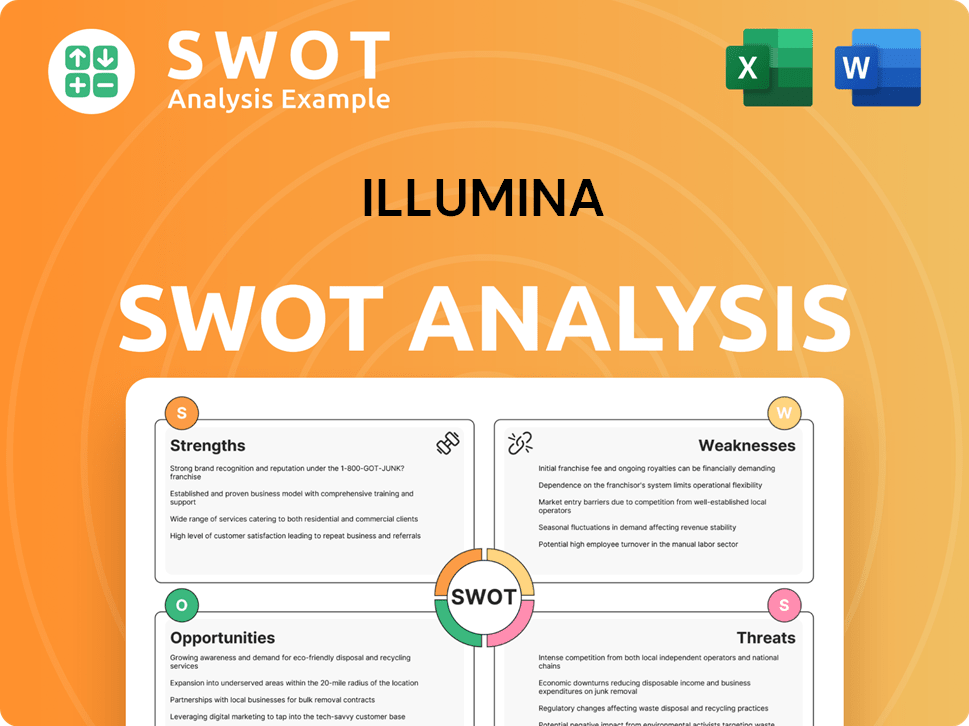
How Has Illumina’s Ownership Changed Over Time?
The evolution of Illumina's ownership structure has been marked by its transition from a private to a public entity. This shift occurred with its initial public offering (IPO) in July 2000. Since then, the ownership has become significantly concentrated among institutional investors. This is a common trend for established biotechnology companies.
As of May 2025, institutional investors hold approximately 99.55% of the shares of the Illumina company. Mutual funds hold around 10.76%. This can be due to investment strategies like leverage or derivatives.
| Shareholder | Holding (as of March 2025) | Shares |
|---|---|---|
| Capital World Investors | 12.06% | 19 million |
| BlackRock, Inc. | 11.84% | 18.7 million |
| The Vanguard Group, Inc. | 10.34% | 16.3 million |
| State Street Global Advisors, Inc. | 3.70% | Not available |
| WCM Investment Management, LLC | 2.64% | Not available |
| Loomis Sayles & Company, L.P. | 2.62% | Not available |
Insiders hold a comparatively small portion of shares, increasing their ownership from 0.30% to 0.34% in May 2025. The increasing institutional ownership reflects broad market participation and confidence in the company's future. The strategic direction and governance of the company are significantly influenced by these major institutional shareholders, as their collective voting power has a substantial impact on corporate decisions.
The ownership of the Illumina company is primarily held by institutional investors, reflecting market confidence. Key institutional shareholders include Capital World Investors, BlackRock, and The Vanguard Group. These major shareholders significantly influence the company's strategic decisions.
- Institutional investors hold approximately 99.55% of the shares.
- Mutual funds hold around 10.76%.
- Insiders own a small percentage, increasing to 0.34% in May 2025.
- Major shareholders influence the company's strategic direction.
Illumina PESTLE Analysis
- Covers All 6 PESTLE Categories
- No Research Needed – Save Hours of Work
- Built by Experts, Trusted by Consultants
- Instant Download, Ready to Use
- 100% Editable, Fully Customizable
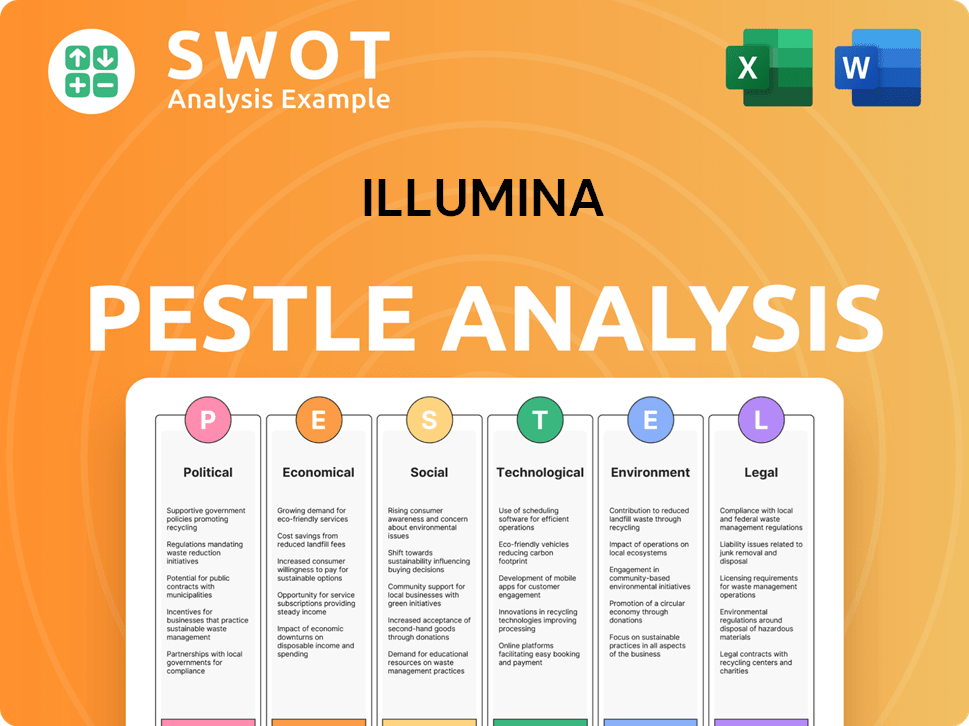
Who Sits on Illumina’s Board?
As of May 21, 2025, the Board of Directors of the Illumina company consists of eleven members. The current board members include Frances Arnold, Caroline Dorsa, Robert Epstein, Scott Gottlieb, Gary Guthart, Keith Meister, Anna Richo, Philip Schiller, Susan Siegel, Jacob Thaysen, and Scott Ullem. Jacob Thaysen serves as the CEO, and Stephen P. MacMillan is the Chairman of the Board. The company's board regularly evaluates its composition to ensure it has the necessary skills and experience to guide the company's future. This is crucial for maintaining effective governance and addressing the challenges and opportunities in the rapidly evolving genomics industry.
The board's composition reflects a commitment to incorporating diverse perspectives and expertise. Illumina's board aims to provide strategic oversight and direction. The board's efforts are focused on supporting the company's long-term goals and enhancing shareholder value. The board's structure and operations are designed to ensure accountability and transparency in the company's decision-making processes. The board's role is pivotal in navigating the complexities of the genomics market and ensuring the company's sustained success and value for its investors.
| Board Member | Role | Additional Information |
|---|---|---|
| Jacob Thaysen | CEO | Leads the company's strategic direction and operations. |
| Stephen P. MacMillan | Chairman of the Board | Oversees the board's activities and ensures effective governance. |
| Frances Arnold | Director | Brings expertise in science and technology. |
| Caroline Dorsa | Director | Provides insights into financial and operational matters. |
| Robert Epstein | Director | Offers expertise in legal and regulatory affairs. |
| Scott Gottlieb | Director | Brings insights into healthcare and policy. |
| Gary Guthart | Director | Offers experience in technology and innovation. |
| Keith Meister | Director | Provides expertise in finance and investment. |
| Anna Richo | Director | Offers insights into legal and compliance matters. |
| Philip Schiller | Director | Brings experience in marketing and product development. |
| Susan Siegel | Director | Offers expertise in business and strategy. |
| Scott Ullem | Director | Provides insights into financial and operational matters. |
Illumina's voting structure typically follows a one-share-one-vote basis for its common stock. Shareholders who were on the record as of March 26, 2025, were eligible to vote at the annual meeting held on May 21, 2025. The agenda of this meeting included the election of directors and other important proposals. The Board of Directors unanimously recommended that shareholders vote 'FOR' their proposed nominees and other proposals. The company's governance structure is designed to protect shareholder interests and ensure that all shareholders have a voice in the company's direction. The voting process is crucial for maintaining accountability and transparency in the company's operations. The voting process is a key aspect of the company's corporate governance framework.
The board's composition is a key factor in shaping the company's strategic direction and responding to shareholder concerns. Illumina's history includes significant events that have influenced its governance and ownership structure. Understanding the dynamics of the board and shareholder voting is essential for anyone interested in Illumina's target market.
- The Board of Directors is responsible for overseeing the company's strategy and operations.
- Shareholders vote on key matters, including the election of directors and other proposals.
- Activist investor campaigns have influenced the company's governance and strategic decisions.
- The company's governance structure is designed to protect shareholder interests.
Illumina Business Model Canvas
- Complete 9-Block Business Model Canvas
- Effortlessly Communicate Your Business Strategy
- Investor-Ready BMC Format
- 100% Editable and Customizable
- Clear and Structured Layout
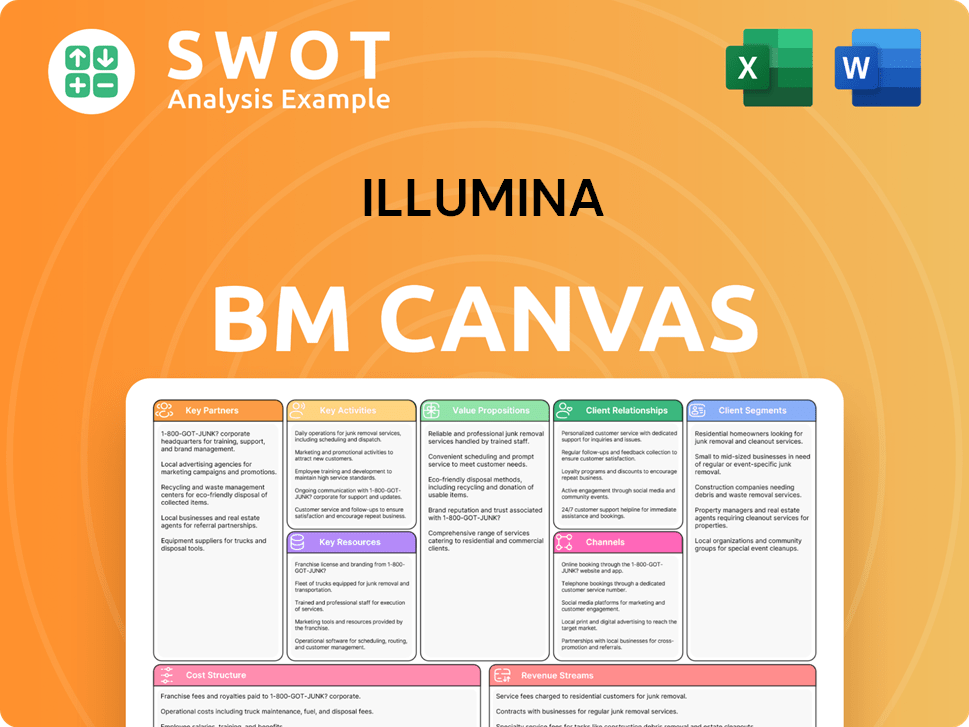
What Recent Changes Have Shaped Illumina’s Ownership Landscape?
Over the past few years, the ownership structure of the Illumina company has undergone significant changes, particularly concerning the strategic handling of GRAIL. A key development was the June 2024 spin-off of GRAIL, a move that allowed the company to focus on its core sequencing business. Following this, Illumina retained a minority stake of 14.5% in GRAIL. This spin-off involved distributing GRAIL shares to Illumina shareholders, with each receiving one share of GRAIL common stock for every six shares of Illumina held as of June 13, 2024.
In terms of ownership trends, institutional investors continue to hold a dominant position in Illumina's shareholder base, with approximately 99.55% of shares held as of May 2025. While insider holdings remain relatively small at 0.34% as of May 2025, there has been an increase in insider buying over the past three months, indicating confidence from company executives. Major institutional investors like Capital World Investors, BlackRock, Inc., and The Vanguard Group, Inc. remain among the largest holders, with positions updated as recently as March 2025. Understanding the Illumina investors and their stake is crucial for anyone looking into Illumina stock.
These strategic financial moves, combined with the GRAIL spin-off, highlight Illumina's efforts to streamline operations and boost shareholder value. The company projects low single-digit constant currency revenue growth for fiscal year 2025, with non-GAAP diluted EPS growth of approximately 10%. For more information about the company's marketing approach, you can read about the Marketing Strategy of Illumina.
Institutional investors hold a significant majority of Illumina shares, underlining their confidence in the company's long-term prospects. This high level of institutional ownership often indicates stability and confidence in the company's direction.
Recent insider buying suggests that company executives believe in Illumina's future. This can be a positive signal for potential investors, as it reflects the confidence of those closest to the company's operations. The increase in insider buying over the past three months is a notable trend.
The spin-off of GRAIL was a strategic move to focus on Illumina's core business and address regulatory concerns. This decision has reshaped the company's structure and is a key factor in understanding the current Illumina ownership landscape.
Illumina's financial strategies, including cost-saving measures, are aimed at improving profitability and shareholder value. The projection of low single-digit revenue growth for 2025 and a 10% growth in non-GAAP diluted EPS reflects the company's financial goals.
Illumina Porter's Five Forces Analysis
- Covers All 5 Competitive Forces in Detail
- Structured for Consultants, Students, and Founders
- 100% Editable in Microsoft Word & Excel
- Instant Digital Download – Use Immediately
- Compatible with Mac & PC – Fully Unlocked
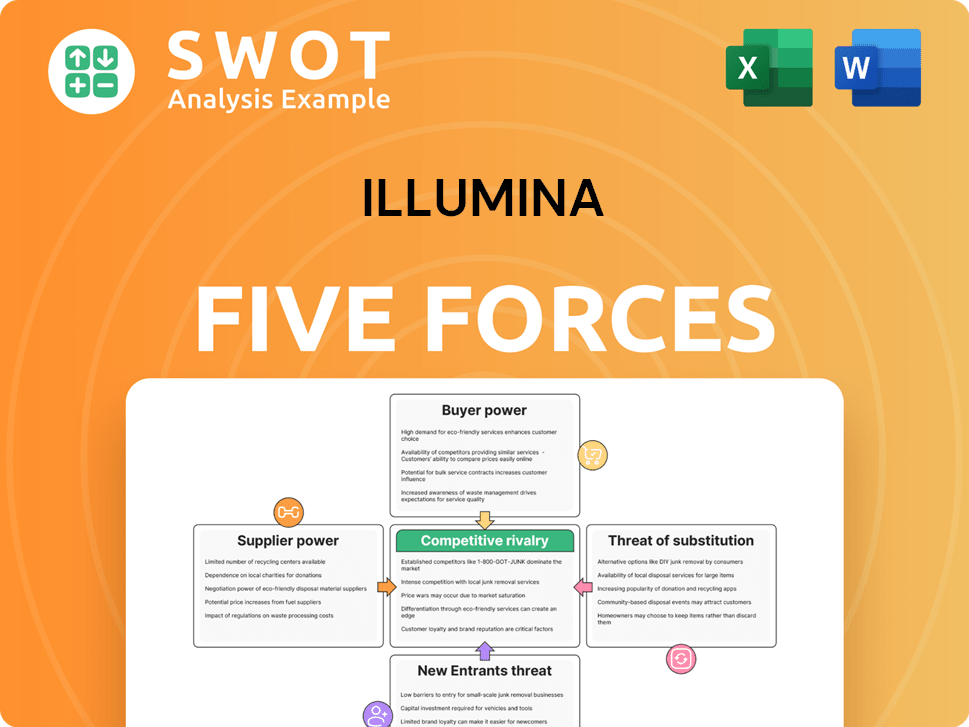
Related Blogs
- What are Mission Vision & Core Values of Illumina Company?
- What is Competitive Landscape of Illumina Company?
- What is Growth Strategy and Future Prospects of Illumina Company?
- How Does Illumina Company Work?
- What is Sales and Marketing Strategy of Illumina Company?
- What is Brief History of Illumina Company?
- What is Customer Demographics and Target Market of Illumina Company?
Disclaimer
All information, articles, and product details provided on this website are for general informational and educational purposes only. We do not claim any ownership over, nor do we intend to infringe upon, any trademarks, copyrights, logos, brand names, or other intellectual property mentioned or depicted on this site. Such intellectual property remains the property of its respective owners, and any references here are made solely for identification or informational purposes, without implying any affiliation, endorsement, or partnership.
We make no representations or warranties, express or implied, regarding the accuracy, completeness, or suitability of any content or products presented. Nothing on this website should be construed as legal, tax, investment, financial, medical, or other professional advice. In addition, no part of this site—including articles or product references—constitutes a solicitation, recommendation, endorsement, advertisement, or offer to buy or sell any securities, franchises, or other financial instruments, particularly in jurisdictions where such activity would be unlawful.
All content is of a general nature and may not address the specific circumstances of any individual or entity. It is not a substitute for professional advice or services. Any actions you take based on the information provided here are strictly at your own risk. You accept full responsibility for any decisions or outcomes arising from your use of this website and agree to release us from any liability in connection with your use of, or reliance upon, the content or products found herein.